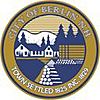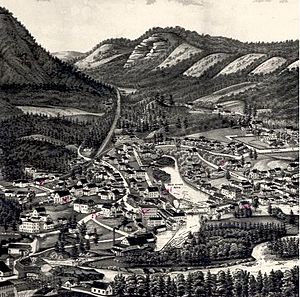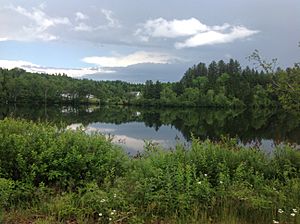Berlin, New Hampshire facts for kids
Quick facts for kids
Berlin, New Hampshire
|
||
|---|---|---|
|
City
|
||
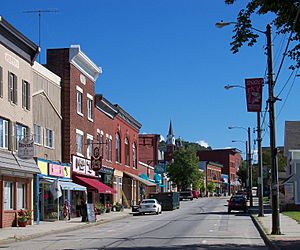
Downtown Berlin
|
||
|
||
| Nicknames:
The City That Trees Built Paper City Tansy Town Hockey Town USA |
||
| Motto(s):
Your Adventure Starts Here
|
||
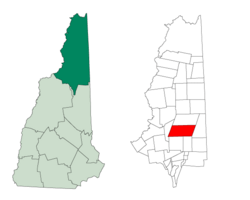
Location in New Hampshire
|
||
| Country | United States | |
| State | New Hampshire | |
| County | Coös | |
| Town | 1829 | |
| City | 1897 | |
| Area | ||
| • Total | 62.20 sq mi (161.10 km2) | |
| • Land | 61.35 sq mi (158.89 km2) | |
| • Water | 0.85 sq mi (2.21 km2) | |
| Elevation | 1,020 ft (310 m) | |
| Population
(2020)
|
||
| • Total | 9,425 | |
| • Density | 153.63/sq mi (59.32/km2) | |
| Time zone | UTC−5 (EST) | |
| • Summer (DST) | UTC−4 (EDT) | |
| ZIP Code |
03570
|
|
| Area code(s) | 603 | |
| FIPS code | 33-05140 | |
| GNIS feature ID | 0871491 | |
Berlin (/ˈbɜːrlɪn/ BUR-lin) is a city located in northern New Hampshire, United States. It sits along the Androscoggin River in Coös County. Berlin is the northernmost city in New Hampshire and the only city in Coös County. In 2020, about 9,425 people lived there.
The city includes the small village of Cascade. Berlin is found in New Hampshire's "North Country" or Great North Woods Region. It is also on the edge of the White Mountains, and part of the city is inside the White Mountain National Forest.
Berlin is home to interesting places like the Berlin and Coos County Historical Society's Moffett House Museum, the Berlin Fish Hatchery, and White Mountains Community College. Many people in Berlin have French Canadian family roots because Quebec is close by. About 65% of residents speak a special kind of French called "Berlin French."
During World War I, the way people said "Berlin" changed. It became BUR-lin instead of Ber-LIN (like Berlin, Germany). This was a way to show patriotism against Germany.
Contents
- Berlin's Early History
- Growth of Industries
- Recent Changes and Economy
- Berlin's Geography
- Berlin's Population and People
- Education in Berlin
- Transportation in Berlin
- Media in Berlin
- Notable People from Berlin
- Sports in Berlin
- Inventions from Berlin
- Historic Sites in Berlin
- Places to Visit in Berlin
- Images for kids
- See also
Berlin's Early History

About 11,000 years ago, Native Americans camped in the area that is now Berlin. Later, the Eastern Abenaki tribes came here to find a special rock called rhyolite in Mt. Jasper.
In 1771, when English colonists were in America, the area was first called "Maynesborough." This name was given by Governor John Wentworth. However, no one settled there at that time.
In 1823–1824, William Sessions and Cyrus Wheeler from Gilead, Maine became the first settlers. They started farming. In 1829, with 65 people living there, the town was officially renamed Berlin. Cyrus's father, Thomas Wheeler, helped make this happen.
Growth of Industries
Berlin is in a very forested area. Because of this, it quickly became a center for logging and wood industries. The Androscoggin River had many waterfalls, which provided water power for sawmills.
In 1851, the St. Lawrence & Atlantic Railroad came to Berlin. This helped connect the town to other markets. In the early 1850s, H. Winslow & Company built a large sawmill. Later, in 1868, William Wentworth Brown and Lewis T. Brown bought the business. They renamed it the Berlin Mills Company.
By 1885, Berlin had several pulp and paper mills. These included the Riverside Mill and Forest Fibre Company. The mills needed many workers. So, immigrants came from countries like Russia, Norway, Finland, Italy, Sweden, Ireland, and Germany. Many others were French Canadians from nearby Quebec.
In 1872, a group of people from Scandinavia started the oldest ski club in the United States. It was first called the North American Ski Club. Later, it was renamed the Nansen Ski Club to honor Fridtjof Nansen, a famous skier. In 1897, Berlin officially became a city.
Recent Changes and Economy
In the early 1900s, Berlin's main industry was making pulp and paper. However, this industry has slowly declined over time. As jobs left, the number of people living in Berlin also went down. The population was over 20,000 in the 1930s, but it's now about half that.
In 1917, the Berlin Mills Company changed its name to the Brown Company. This was because of World War I and strong feelings against Germany. After the Great Depression, the Brown Company faced difficulties. It was bought and sold many times after World War II.
In 2006, the Fraser Papers pulp mill in Berlin closed, causing many people to lose their jobs. Later, a company bought the old mill site to tear it down and allow new businesses to develop. A part of the site was bought by Laidlaw Energy LLC. They plan to turn a large boiler into a power plant that uses biomass (natural materials) to make electricity.
Since the 1990s, Berlin's economy has also grown with the correctional industry. The Northern New Hampshire Correctional Facility was built in 1999. It employs about 200 people. In 2012, the Federal Bureau of Prisons opened a larger federal prison, which employs about 350 people.
A local historian named Paul "Poof" Tardiff wrote many articles about Berlin's history. He collected them in a series called Once Upon a Berlin Time. He continued writing for The Berlin Daily Sun until he passed away in 2018.
Berlin's Geography
Berlin is located in northern New Hampshire, just north of the White Mountains. The city is surrounded by other towns like Randolph, Gorham, Milan, Success, and Kilkenny.
New Hampshire Route 16 goes through the city center. It leads north to Errol and south to North Conway. New Hampshire Route 110 goes northwest from Berlin to Groveton.
The city covers about 62 square miles (161 square kilometers). Most of this is land, with a small amount of water. Berlin is where the Androscoggin and Dead rivers meet. The Mahoosuc Range mountains are to the southeast.
Jericho Mountain State Park is west of the city center. It has a reservoir and many trails for ATVs. The highest point in Berlin is Mount Weeks, which is 3,901 feet (1,189 meters) above sea level. Another important mountain is Mount Forist, which is 2,031 feet (619 meters) tall and rises over the west side of the city.
Rivers in Berlin
Berlin's Climate
Berlin has cold, snowy winters and warm summers. This is typical for northern New England. Winters can be very cold, with temperatures sometimes dropping far below zero. The coldest temperature ever recorded was -44°F (-42°C). On average, Berlin gets about 80 inches (2 meters) of snow each year.
Summers are usually mild. However, sometimes strong storms can bring heavy rain. The hottest temperature ever recorded was 98°F (37°C).
| Climate data for Berlin, New Hampshire (1991–2020 normals; extremes 1886 to 1892 and since October 1917) | |||||||||||||
|---|---|---|---|---|---|---|---|---|---|---|---|---|---|
| Month | Jan | Feb | Mar | Apr | May | Jun | Jul | Aug | Sep | Oct | Nov | Dec | Year |
| Record high °F (°C) | 67 (19) |
69 (21) |
80 (27) |
89 (32) |
94 (34) |
98 (37) |
98 (37) |
97 (36) |
95 (35) |
88 (31) |
77 (25) |
68 (20) |
98 (37) |
| Mean maximum °F (°C) | 51.0 (10.6) |
50.8 (10.4) |
58.8 (14.9) |
76.7 (24.8) |
84.6 (29.2) |
88.6 (31.4) |
88.8 (31.6) |
87.0 (30.6) |
84.1 (28.9) |
75.3 (24.1) |
65.4 (18.6) |
53.1 (11.7) |
90.8 (32.7) |
| Mean daily maximum °F (°C) | 26.9 (−2.8) |
29.7 (−1.3) |
38.4 (3.6) |
51.9 (11.1) |
65.5 (18.6) |
73.7 (23.2) |
78.2 (25.7) |
76.8 (24.9) |
69.5 (20.8) |
56.6 (13.7) |
44.0 (6.7) |
32.4 (0.2) |
53.6 (12.0) |
| Daily mean °F (°C) | 16.1 (−8.8) |
18.0 (−7.8) |
27.2 (−2.7) |
40.6 (4.8) |
53.0 (11.7) |
61.9 (16.6) |
66.5 (19.2) |
64.7 (18.2) |
57.4 (14.1) |
45.9 (7.7) |
34.9 (1.6) |
23.3 (−4.8) |
42.5 (5.8) |
| Mean daily minimum °F (°C) | 5.4 (−14.8) |
6.3 (−14.3) |
16.0 (−8.9) |
29.4 (−1.4) |
40.6 (4.8) |
50.1 (10.1) |
54.9 (12.7) |
52.5 (11.4) |
45.2 (7.3) |
35.1 (1.7) |
25.7 (−3.5) |
14.1 (−9.9) |
31.3 (−0.4) |
| Mean minimum °F (°C) | −15.5 (−26.4) |
−11.8 (−24.3) |
−5.5 (−20.8) |
17.9 (−7.8) |
29.4 (−1.4) |
37.9 (3.3) |
45.9 (7.7) |
42.0 (5.6) |
32.1 (0.1) |
24.1 (−4.4) |
10.5 (−11.9) |
−5.7 (−20.9) |
−17.7 (−27.6) |
| Record low °F (°C) | −35 (−37) |
−39 (−39) |
−29 (−34) |
−9 (−23) |
18 (−8) |
29 (−2) |
33 (1) |
31 (−1) |
20 (−7) |
8 (−13) |
−13 (−25) |
−44 (−42) |
−44 (−42) |
| Average precipitation inches (mm) | 2.73 (69) |
2.44 (62) |
3.00 (76) |
3.43 (87) |
3.55 (90) |
4.23 (107) |
4.08 (104) |
3.75 (95) |
3.35 (85) |
4.92 (125) |
3.39 (86) |
3.73 (95) |
42.60 (1,082) |
| Average snowfall inches (cm) | 18.2 (46) |
21.0 (53) |
16.1 (41) |
4.2 (11) |
0.2 (0.51) |
0.0 (0.0) |
0.0 (0.0) |
0.0 (0.0) |
0.0 (0.0) |
0.5 (1.3) |
4.6 (12) |
17.2 (44) |
82.0 (208) |
| Average extreme snow depth inches (cm) | 16.1 (41) |
21.7 (55) |
19.7 (50) |
5.8 (15) |
0.2 (0.51) |
0.0 (0.0) |
0.0 (0.0) |
0.0 (0.0) |
0.0 (0.0) |
0.5 (1.3) |
3.2 (8.1) |
12.9 (33) |
26.4 (67) |
| Average precipitation days (≥ 0.01 in) | 10.2 | 9.1 | 10.0 | 10.5 | 12.1 | 12.3 | 11.8 | 10.3 | 9.3 | 11.7 | 10.2 | 12.2 | 129.7 |
| Average snowy days (≥ 0.1 in) | 7.6 | 6.6 | 5.3 | 1.9 | 0.1 | 0.0 | 0.0 | 0.0 | 0.0 | 0.4 | 2.6 | 7.3 | 31.8 |
| Source: NOAA | |||||||||||||
Berlin's Population and People
| Historical population | |||
|---|---|---|---|
| Census | Pop. | %± | |
| 1830 | 73 | — | |
| 1840 | 116 | 58.9% | |
| 1850 | 173 | 49.1% | |
| 1860 | 433 | 150.3% | |
| 1870 | 529 | 22.2% | |
| 1880 | 1,144 | 116.3% | |
| 1890 | 3,729 | 226.0% | |
| 1900 | 8,886 | 138.3% | |
| 1910 | 11,780 | 32.6% | |
| 1920 | 16,104 | 36.7% | |
| 1930 | 20,018 | 24.3% | |
| 1940 | 19,084 | −4.7% | |
| 1950 | 16,615 | −12.9% | |
| 1960 | 17,821 | 7.3% | |
| 1970 | 15,256 | −14.4% | |
| 1980 | 13,084 | −14.2% | |
| 1990 | 11,824 | −9.6% | |
| 2000 | 10,331 | −12.6% | |
| 2010 | 10,051 | −2.7% | |
| 2020 | 9,425 | −6.2% | |
| U.S. Decennial Census | |||
In 2010, Berlin had 10,051 people living in 4,178 households. Most residents (96.5%) were white. About 1.5% of the population was Hispanic or Latino.
The average household had about 2.18 people. The median age in the city was 44.7 years old. This means half the people were older than 44.7 and half were younger.
Berlin's population grew very quickly from 1880 to 1930. It went from 1,144 people to over 20,000. After 1930, the population slowly started to decrease. By 2020, it was 9,425.
In the 1930s, Berlin was at its busiest. Downtown Berlin had many local family-owned businesses. The Nansen Ski Jump, built in 1936, was a major attraction. It was the largest ski jump in the eastern United States for almost 50 years. It closed in 1988 but was fully repaired in 2017.
Ancestry of Berlin Residents
Many people in Berlin have French Canadian roots. In 2000, about 43.4% of residents identified as French Canadian. Another 20.0% identified as French. This shows the strong influence of French culture in the city.
| Main Ancestries of Berlin Residents, 2000 | |||||
|---|---|---|---|---|---|
| Ancestry | Total Respondents 9,079 | Percentage of Total Respondents | |||
| French Canadian | 3,937 | 43.4% | |||
| French | 1,817 | 20.0% | |||
| American | 673 | 7.4% | |||
| Total | 6,427 | 70.8% | |||
Education in Berlin
Berlin has public schools managed by Berlin Public Schools.
- Berlin Middle High School serves students in grades 6 through 12.
- Berlin Elementary School serves students in grades K (kindergarten) through 5.
For higher education, Berlin is home to White Mountains Community College. This college is part of the Community College System of New Hampshire.
Transportation in Berlin
The main roads in Berlin are New Hampshire Route 16 and New Hampshire Route 110. Route 16 connects Berlin to towns like Gorham to the south and Milan to the north. Route 110 starts in downtown Berlin and goes northwest to Groveton.
Berlin is also the northern end point for a bus route run by Concord Coach Lines. This route connects Berlin to Conway and New Hampton.
There are two airports close to Berlin: Berlin Regional Airport and Gorham Airport.
Media in Berlin
Radio Stations
- WKDR 1490 AM: Plays Classic Hits and Classic Rock music.
- WMOU 1230 AM: Plays Hot Adult Contemporary music (also on 106.1 FM).
- WVMJ 98.1 FM: Plays Top 40 music (also on 104.5 FM).
Documentaries
- At the River's Edge is a documentary that tells the history of Berlin through interviews with local people.
Newspapers
- The Berlin Daily Sun
- The Berlin Reporter (published from 1900 to 2024)
Notable People from Berlin
Many interesting people have come from Berlin, New Hampshire. Here are a few:
- William Robinson Brown (1875–1955): A business leader and famous horse breeder.
- Lew Cody (1884–1934): An actor popular in the 1920s and 1930s.
- William E. Corbin (1869–1951): The inventor of the Nibroc paper towel.
- Michael Durant (born 1961): A U.S. Army pilot who was shot down and held prisoner during the Battle of Mogadishu.
- Bruce Halle (1930–2018): The person who started Discount Tire company.
- Earl Silas Tupper (1907–1983): The inventor of Tupperware.
Sports in Berlin
Berlin has a strong connection to hockey. The city's Notre Dame Arena hosted a professional hockey team called the Berlin River Drivers from 2015 to 2017. In 2018, another professional team, the Berlin BlackJacks, played there briefly before moving.
Inventions from Berlin
Several interesting things were invented or developed in Berlin:
- Bermico: A type of pipe made by the Brown Company from the 1920s to the 1970s.
- Cellulose floc: A material developed by the Brown Company.
- Farrand Rapid Rule: A special measuring tape created by Hiram A. Farrand Inc.
- Iron rigging: A part for skis made by Olaf Oleson.
- Kream Krisp: A cooking substance similar to Crisco, created by the Brown Company.
- Nibroc Paper Towels: Developed by William E. Corbin and made in large amounts by the Brown Company.
Historic Sites in Berlin
Berlin has several places that are listed on the National Register of Historic Places. This means they are important for their history or architecture.
- Congregational Church (added in 1980)
- George E. Burgess School (added in 2015)
- Holy Resurrection Orthodox Church (added in 1979)
- Mt. Jasper Lithic Source (added in 1992)
- St. Anne Church (added in 1979)
Places to Visit in Berlin
- Nansen Ski Jump: A historic ski jump.
- The Berlin & Coös County Historical Society (BCCHS): Learn about local history.
- Moffett House Museum and Genealogical Center: A museum with family history records.
- Notre Dame Arena: A place for sports and events.
- Service Credit Union Heritage Park: A park celebrating Berlin's history.
- Jericho Mountain State Park: Great for outdoor activities like ATV riding.
Images for kids
-
Mount Forest around 1912
-
A group of Russian immigrants at the Holy Resurrection Orthodox Church in 1915
See also
 In Spanish: Berlin (Nuevo Hampshire) para niños
In Spanish: Berlin (Nuevo Hampshire) para niños


